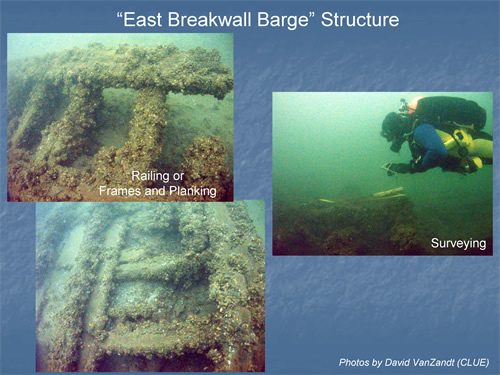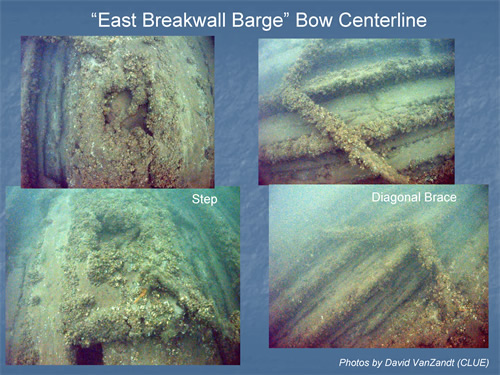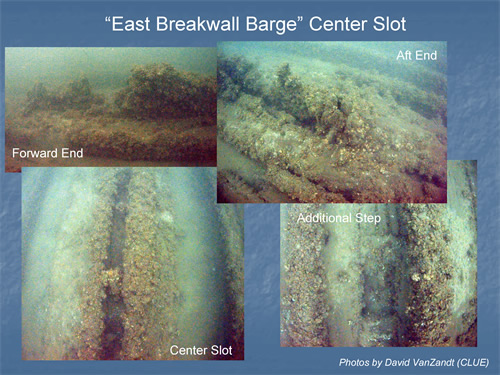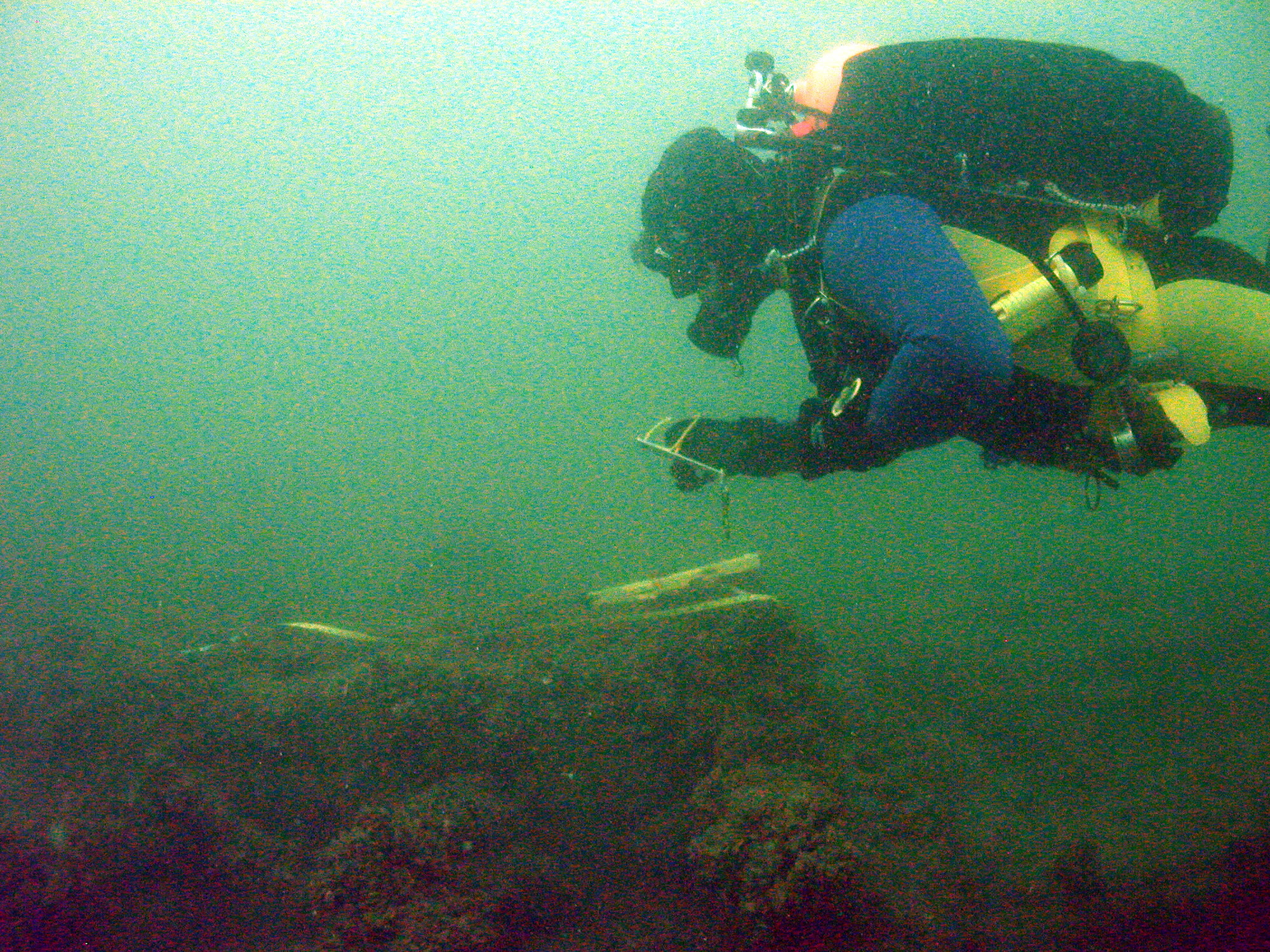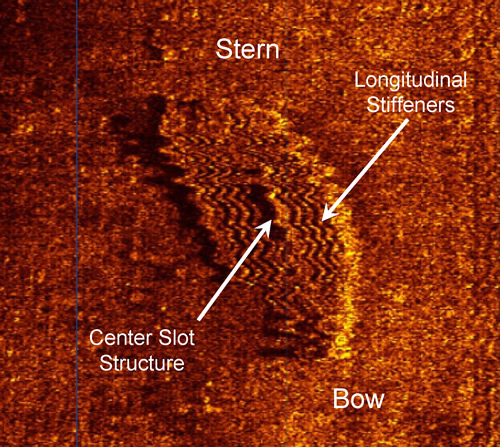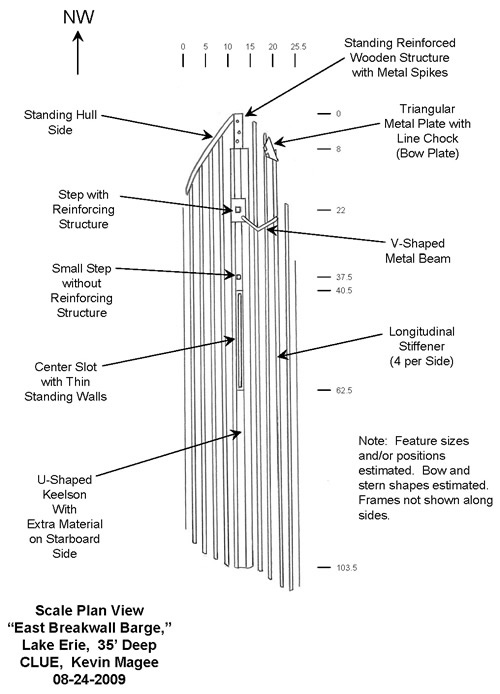East Breakwall Barge
SHIP INFORMATION
| Ship Name: | East Breakwall Barge |
|---|---|
| Also Known As: | |
| Type of Ship: | |
| Ship Size: | |
| Ship Owner: | |
| Gross Tonnage: | |
| Net Tonnage: | |
| Typical Cargo: | |
| Year Built: |
WRECK SITE INFORMATION
| Official Wreck Number: | |
|---|---|
| Wreck Location: | |
| Type of Ship at Loss: | |
| Cargo on Ship at Loss: | |
| Captain of Ship at Loss: | |
CLUE, 2009-08-24 – “East Breakwall Barge”
While searching off Cleveland’s eastern breakwall on August 16, 2009, David VanZandt and Kevin Magee of the Cleveland Underwater Explorers (CLUE) found a large shipwreck. Dave suited up and dove to explore the wreck immediately after its discovery, but Kevin had left all his dive gear at home and was unable to dive that day. However, on the afternoon of August 24, 2009, Dave and Kevin returned to dive and document the newly discovered shipwreck. The water was calm with only 1-2 foot swells from the east that were calming to produce an eventually flat lake. The surface visibility was great at 10-15 feet, and the water temperature was a warm 77-78 deg F. Both the visibility and temperature continued all the way to the bottom.
The wreck is a large wooden ship that has been mostly flattened since it would have been most likely a hazard to navigation after it sank. Therefore, only the bottom portions of the wreck remain a couple of feet off the bottom. However, the bow, which points northwest, contains some 3-4 foot high standing structure on the port side. The bow does not have a definite pointed shape, but the sides can be seen to be narrowing as they approach the bow. The starboard side seems to have been pulled away and is mostly flattened. Along the centerline of the bow is a large, beefy structure that stands 3-4 feet high with large metal spikes coming out of its top along its 8-foot length. In general, it appears the bow was greatly strengthened in this area. On the starboard side at the very edge of the wreck before it drops to the sandy bottom is a large triangular metal plate with a line chock molded into its apex. This was most likely originally located at the bow and suggests the vessel was towed, thus tentatively identifying it as a barge.
A striking feature of the shipwreck is the extreme strength of its hull. Longitudinal stiffeners, or stringers, with four on each side of the keelson, are present along the length of the ship. Additionally, the hull’s frames are closely spaced with roughly 2 feet between them. The ship is relatively large at about 103 feet in length with an approximately 26-foot beam. The frames are broken at the turn of the bilge as a result of its being leveled, so it is unknown how high the hull stood. Aft of the bow, a step is encountered along the keelson. This step is square in shape with a built-up rectangular area around the square hole. Off to the starboard side and slightly aft is a V-shaped piece of metal with one leg touching the step. Strangely, this piece, which would appear to be a strengthening beam, points aft with its vertex centered on the first stringer starboard of the centerline. Continuing aft along the centerline, another smaller step is sunken into the keelson without any raised rectangular framing.
The 3.5 foot-wide keelson is U-shaped with a non-symmetrical shape from an apparently extra sister keelson being present on the starboard side. Forty feet back from the bow along the centerline is what appears to be a small
centerboard box but is really more of a center slot. It is 22 feet in length but is irregular and broken, undersized with only a 6-inch width and 3-inch thick walls, and has small center posts coming out of the slot, which suggests it is something other than a centerboard. Its exact purpose is unknown. No more unusual features are found aft of this center slot until the broken stern is encountered. The stern structure is not well defined, and there is no transom. However, it does appear that the stern was generally square in shape. Trailing off into a debris field behind the stern for some distance are wooden pieces and small stones. These were easily found due to the excellent visibility. Small stones and some small wooden debris can also be found off to the sides of the wreck. Found among the starboard bow wreckage were some small unidentified metal pieces such as a metal pipe with a flange and spike with a flange.
Dave took photographs while Kevin measured and took notes to be able to produce a sketch of the wreck. Overall, the wreck appears to be a wooden barge that was carrying small stone, possibly to work on the breakwall. Its identity is unknown, but ongoing research and a more detailed survey may reveal more about this wreck. This is a substantial unknown wreck close to Cleveland and is of significant interest.
While searching off Cleveland’s eastern breakwall on August 16, 2009, David VanZandt and Kevin Magee of the Cleveland Underwater Explorers (CLUE) found a large shipwreck. Dave suited up and dove to explore the wreck immediately after its discovery, but Kevin had left all his dive gear at home and was unable to dive that day. However, on the afternoon of August 24, 2009, Dave and Kevin returned to dive and document the newly discovered shipwreck. The water was calm with only 1-2 foot swells from the east that were calming to produce an eventually flat lake. The surface visibility was great at 10-15 feet, and the water temperature was a warm 77-78 deg F. Both the visibility and temperature continued all the way to the bottom.
The wreck is a large wooden ship that has been mostly flattened since it would have been most likely a hazard to navigation after it sank. Therefore, only the bottom portions of the wreck remain a couple of feet off the bottom. However, the bow, which points northwest, contains some 3-4 foot high standing structure on the port side. The bow does not have a definite pointed shape, but the sides can be seen to be narrowing as they approach the bow. The starboard side seems to have been pulled away and is mostly flattened. Along the centerline of the bow is a large, beefy structure that stands 3-4 feet high with large metal spikes coming out of its top along its 8-foot length. In general, it appears the bow was greatly strengthened in this area. On the starboard side at the very edge of the wreck before it drops to the sandy bottom is a large triangular metal plate with a line chock molded into its apex. This was most likely originally located at the bow and suggests the vessel was towed, thus tentatively identifying it as a barge.
A striking feature of the shipwreck is the extreme strength of its hull. Longitudinal stiffeners, or stringers, with four on each side of the keelson, are present along the length of the ship. Additionally, the hull’s frames are closely spaced with roughly 2 feet between them. The ship is relatively large at about 103 feet in length with an approximately 26-foot beam. The frames are broken at the turn of the bilge as a result of its being leveled, so it is unknown how high the hull stood. Aft of the bow, a step is encountered along the keelson. This step is square in shape with a built-up rectangular area around the square hole. Off to the starboard side and slightly aft is a V-shaped piece of metal with one leg touching the step. Strangely, this piece, which would appear to be a strengthening beam, points aft with its vertex centered on the first stringer starboard of the centerline. Continuing aft along the centerline, another smaller step is sunken into the keelson without any raised rectangular framing.
The 3.5 foot-wide keelson is U-shaped with a non-symmetrical shape from an apparently extra sister keelson being present on the starboard side. Forty feet back from the bow along the centerline is what appears to be a small
centerboard box but is really more of a center slot. It is 22 feet in length but is irregular and broken, undersized with only a 6-inch width and 3-inch thick walls, and has small center posts coming out of the slot, which suggests it is something other than a centerboard. Its exact purpose is unknown. No more unusual features are found aft of this center slot until the broken stern is encountered. The stern structure is not well defined, and there is no transom. However, it does appear that the stern was generally square in shape. Trailing off into a debris field behind the stern for some distance are wooden pieces and small stones. These were easily found due to the excellent visibility. Small stones and some small wooden debris can also be found off to the sides of the wreck. Found among the starboard bow wreckage were some small unidentified metal pieces such as a metal pipe with a flange and spike with a flange.
Dave took photographs while Kevin measured and took notes to be able to produce a sketch of the wreck. Overall, the wreck appears to be a wooden barge that was carrying small stone, possibly to work on the breakwall. Its identity is unknown, but ongoing research and a more detailed survey may reveal more about this wreck. This is a substantial unknown wreck close to Cleveland and is of significant interest.
STORY OF THE LOSS
INTERESTING FACTS
CITED SOURCES
Van Zandt, D. and Magee, K. 2009. CLUE, 2009-08-24-East Breakwall Barge. Retrieved on May 13, 2019 at: http://www.clueshipwrecks.org/PDFs/CLUE_2009-08-24_East_Breakwall_Barge.pdf

